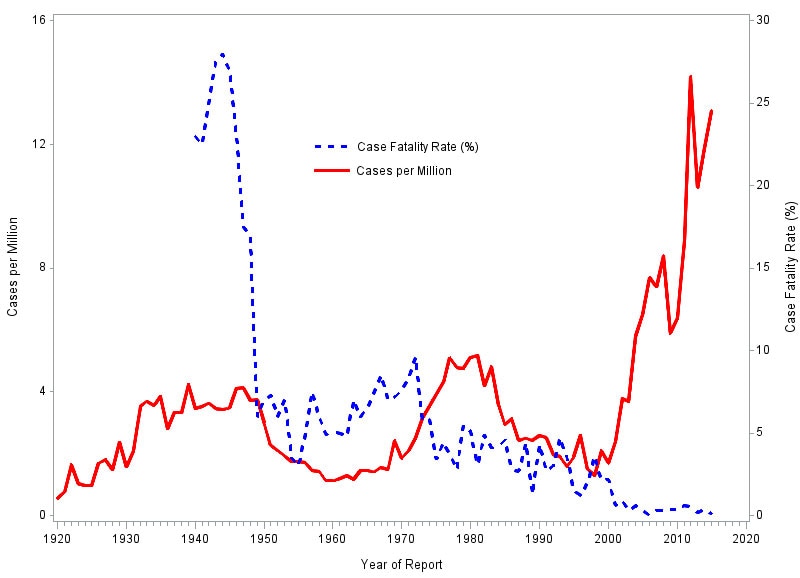skip to main |
skip to sidebar
Epidemiology and Statistics | Rocky Mountain Spotted Fever (RMSF) | CDC
Epidemiology and Statistics | Rocky Mountain Spotted Fever (RMSF) | CDC

- Rocky Mountain spotted fever (RMSF) has been a nationally notifiable condition since the 1920s.
- As of January 1, 2010, cases of RMSF are reported under a new category called Spotted Fever Rickettsiosis (SFR).
- This category captures cases of RMSF, Rickettsia parkeri rickettsiosis, Pacific Coast tick fever, and rickettsialpox.
- The change reflects the inability to differentiate between spotted fever group Rickettsia species using commonly available serologic tests.
At a glance
- In 2000, 495 cases of spotted fever rickettsiosis were reported, while in 2016, more than 4,269 cases were reported.
- In 2016 more than 4,269 cases were reported. It is unclear how many of those cases are RMSF, and how many result from other, less severe spotted fevers.
Epidemiology Figure 1 – Number of U.S. SFR cases reported to CDC, 2000–2016

Historical trends
- The number of cases of SFR reported to CDC per year have generally increased over time with distinct increase numbers since the mid 1990s.
- Notably, while the number of cases and incidence rose, the case fatality rate (i.e., the proportion of spotted fever rickettsiosis patients that died as a result of infection) has declined since the 1940s when tetracycline antibiotics became available.
- The current case fatality rate for spotted fever rickettsioses using surveillance data is still roughly 0.5% of cases.
- In clinical reviews of RMSF cases, about 5-10% of cases are fatal.
- Inclusion of less severe spotted fevers, such as R. parkeri rickettsiosis, likely leads to the lower case fatality rate observed in recent decades.
Epidemiology Figure 2 – Reported incidence and case fatality of SFR in the United States, 1920–2015

Seasonality
- Although cases of SFR can occur during any month of the year, most cases reported illness in June and July.
- This period coincides with the season when adult Dermacentor ticks are most active.
- Seasonal trends may vary depending on the area of the country and tick species involved.
- In Arizona, the majority of SFR cases are spread by the brown dog tick and cases occur year-round with peak months of illness onset April through October.
Epidemiology Figure 3 – Number of reported SFR cases by month of onset, 2000–2016

Geography
- SFR cases have been reported throughout the contiguous United States, although five states (North Carolina, Oklahoma, Arkansas, Tennessee, and Missouri) account for over 60% of SFR cases.
- In Arizona, RMSF cases have recently been identified in an area where the disease had not been previously seen. From 2003 to 2017, nearly 380 cases were reported with a case-fatality rate of about 10%.
- The tick responsible for transmission of R. rickettsii in Arizona is the brown dog tick (Rhipicephalus sanguineus sensu lato), which is found on dogs and in and around people’s homes.
- Almost all of the cases occurred within communities with large numbers of free-roaming dogs.
Epidemiology Figure 4 – Annual incidence (per million persons) for SFR in the United States, 2016

People at Risk
- Cases of SFR are more frequently reported in men than in women.
- Incidence of SFR is higher in American Indians than other groups.
- People over the age of 40 years account for the highest number of reported cases, however, children under 10 years old represent the highest number of reported deaths.
- Persons with glucose-6-phosphate dehydrogenase (G6PD) deficiency.
- Surveillance data shows higher risk for hospitalization in people with compromised immune systems (e.g., resulting from cancer treatments, advanced HIV infection, prior organ transplants, or some medications).
Epidemiology Figure 5 – Average annual incidence of SFR by age group, 2000–2016
































.png)











No hay comentarios:
Publicar un comentario